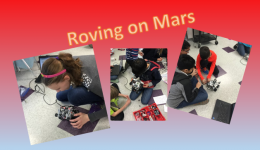This lesson is for : Grade 4:
Summary
NASA’s Digital Learning Network at the Johnson Space Center present a lesson via Skype entitled Robotics in Space. Students sitting in classrooms today represent the Mars Generation, the future scientists, engineers, mathematicians, and astronaut explorers who will take the first steps on the Red Planet. The difficult challenge of getting astronauts to Mars and returning them safely to Earth requires a thorough understanding of the Martian environment for the safe operation of equipment and for human health. The Mars Exploration Program is already looking at these challenges and using robotic missions to demonstrate technology and help scientists answer questions about the habitability of Mars. The students’ challenge is to brainstorm, design, test, and redesign a model of a Mars rover using Lego Mindstorm EV3 robotics.
TIPC Ratings
Research & Information Fluency
Rating: Ideal – Explanation: Throughout the project the students were actively engaged in research. They were required to assemble and synthesize the information collected in order to accurately apply it to the creation and design their rovers. Information was powerfully displayed by the students’ final products. The teacher was continually observing, facilitating, and challenging the students from beginning to end to task risks with their research.
Communication & Collaboration
Rating: Ideal – Explanation: Collaboration was a huge component of this project. The students worked together to research, design, and communicate ideas in order to reach a common goal. Our Skype session with Johnson Space Center in Texas was an essential part of the communication, collaboration, and learning process. The students continued to reflect using their engineering journals and rubrics as a self-assessment and guide throughout the project. Furthermore, students completed a feedback and reflection form.
Critical Thinking & Problem Solving
Rating: Ideal – Explanation: Each section of this project required enormous amounts of critical thinking and problem solving. The whole design process centered around the students’ abilities to analyze and problem solve with real life application. Throughout the entire project, the students were continually asked, “What could you do differently next time?”, “How could you make this better?”, “What did you learn that you could apply to the next project?”, “What kinds of modifications could you make?” Ultimately, students used the knowledge gleaned from prior lessons to develop their own unique projects/products by the end of each lesson.
Creativity & Innovation
Rating: Ideal – Explanation: The students were challenged to take what they learned from their research and connect it to their own prior knowledge in order to come up with something new and innovative with their capsule and rover designs.



